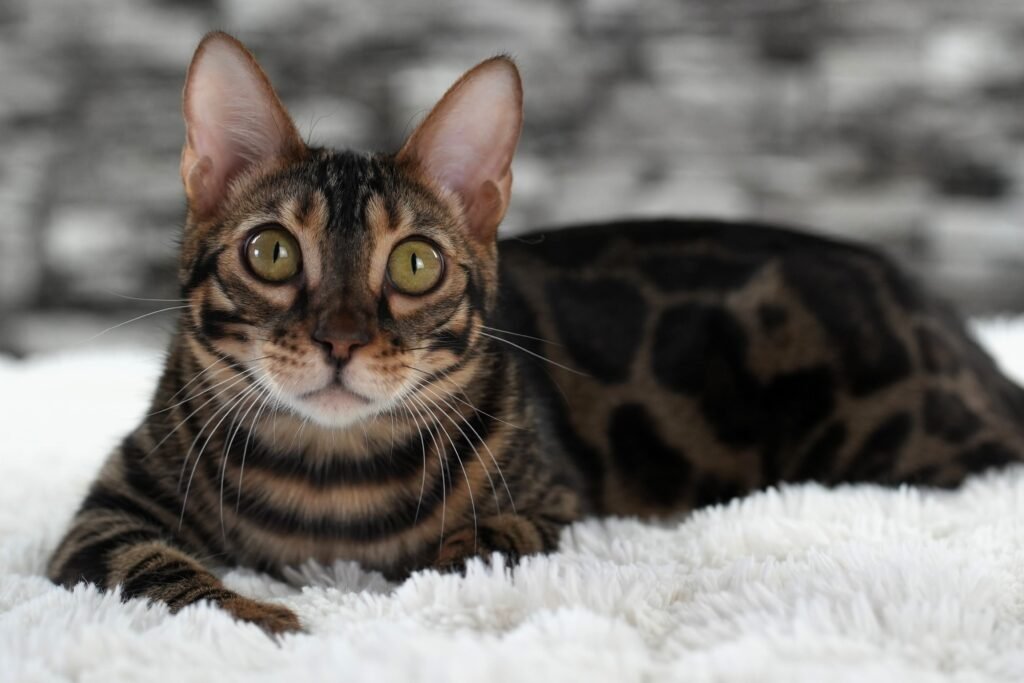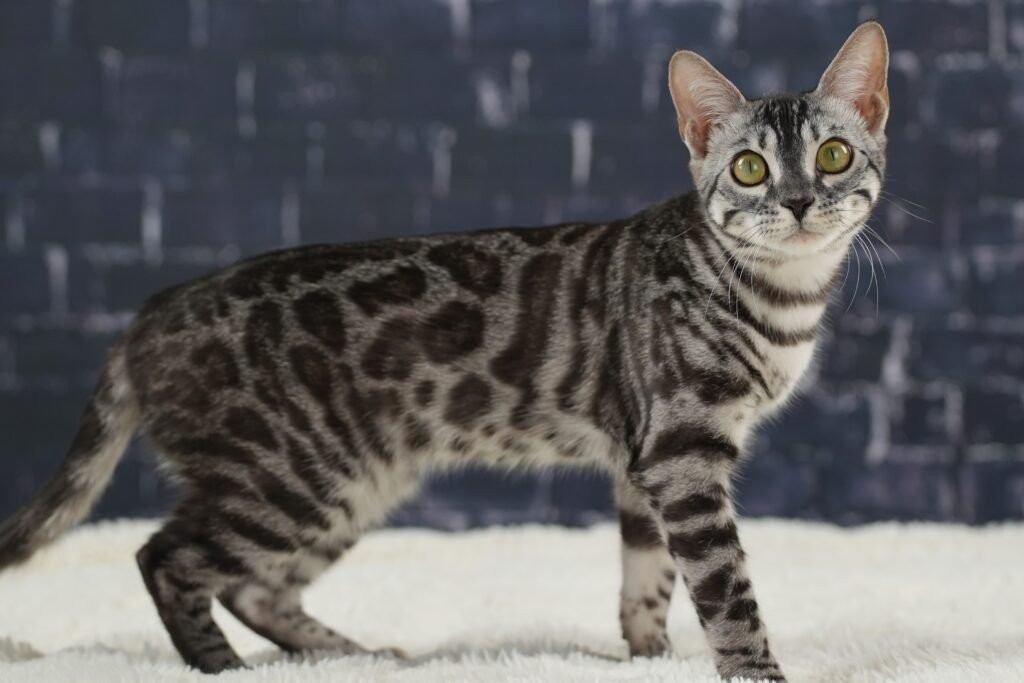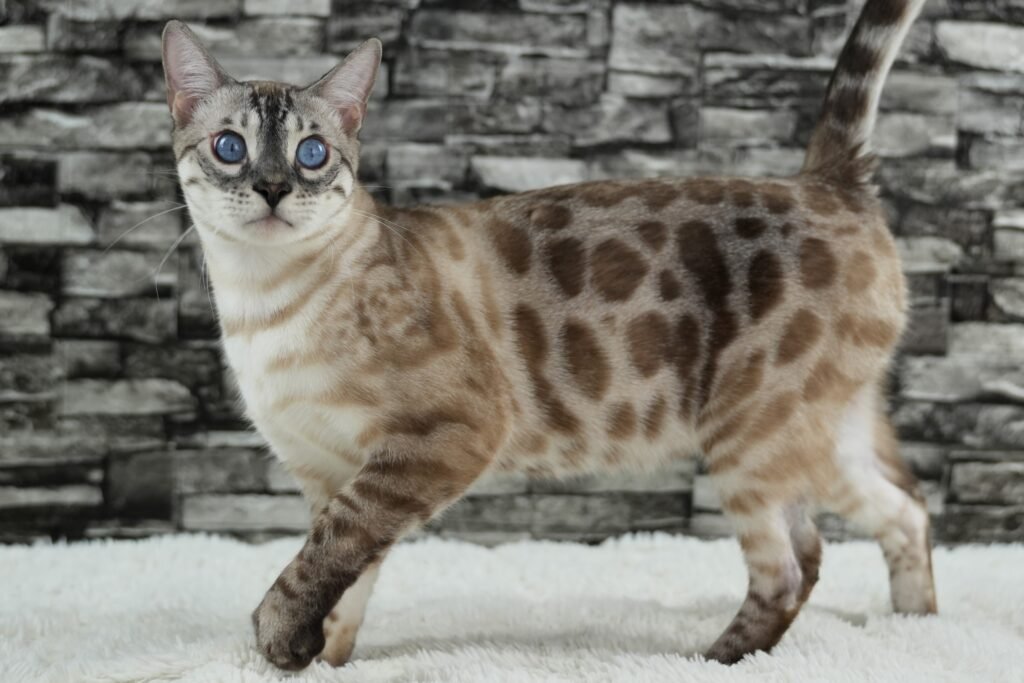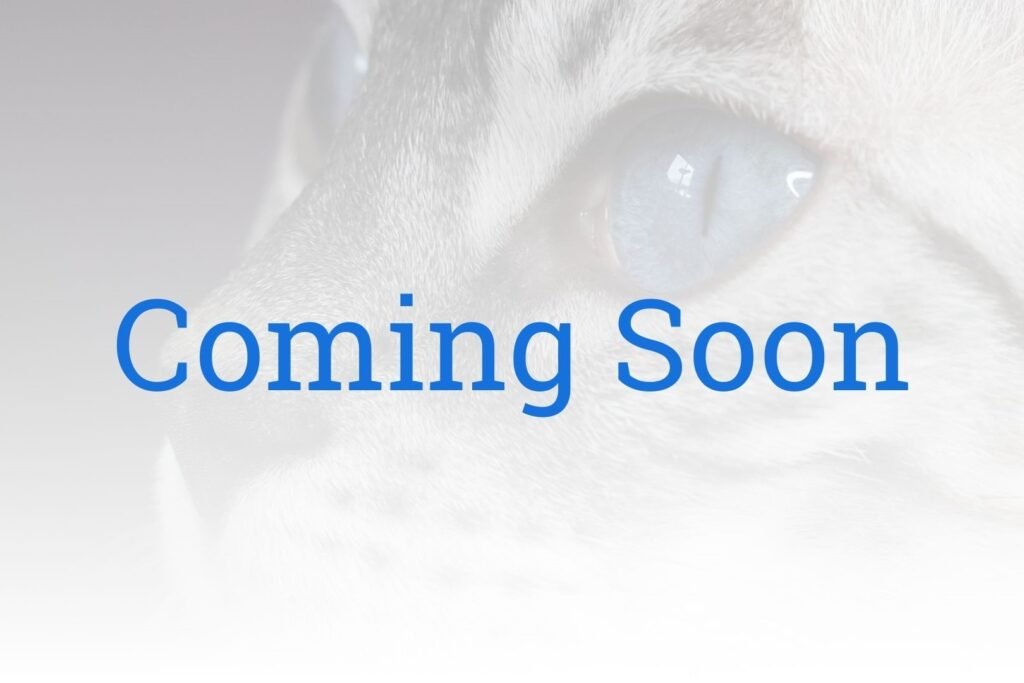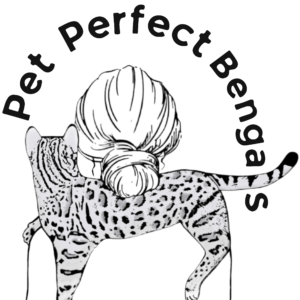
Black Bengals Cat
The term “Black Bengal” is often used to refer to Bengal cats with a very dark coat. In reality, there are two distinct variations of Black Bengal cats: the Charcoal Bengal and Melanistic Bengal. These cats possess specific genetic traits that result in their dark coloration. Understanding the distinctions between these two variations is important for accurate communication among cat enthusiasts and breeders, as it affects breeding programs and show standards.
Charcoal Bengal Cat
The charcoal Bengal’s overall appearance gives the impression of a shadow cast over the cat. Their markings are typically filled with an inky black color, creating a striking contrast against their background. The intensity of the charcoal effect can vary between individuals, with some cats displaying more pronounced Zorro markings than others.
Melanistic Bengal Cat
The Melanistic pattern effect manifests differently across various Bengals. On brown Bengals, it produces the classic “melanistic” or “panther” appearance. Interestingly, it has no visible effect on red Bengals. When present in snow Bengals, it results in a “solid” effect, while on silver Bengals, it creates a mysterious “smoke” hue.
History of the Charcoal Bengal Cat: Redefining Wild Beauty
In 2014, a groundbreaking study titled “Who’s behind that mask and cape?” provided scientific insights into the charcoal pattern’s genetic basis. Researchers identified a specific Agouti allele (ASIP) variant from the Asian Leopard Cat as likely responsible for the charcoal coloration when interacting with domestic cat genes. This research offered valuable explanations for breeders and geneticists, demonstrating how wild traits can manifest differently in hybrid breeds.
As interest grew and genetic research progressed, appreciation for charcoal Bengals increased. Their striking appearance showcased the breed’s wild heritage transformed charcoal from an undesirable trait to a sought-after variation.
The Cat Fanciers’ Association (CFA) accepted Bengals for registration in 2016, paving the way for charcoal Bengals in the show ring. BOYDSBENGALS PRINCESS CLEOPATRA made history in the 2019 show season as the first charcoal Bengal to win CFA’s Grand Premier title. The following year, BOYDSBENGALS STORM BREAKER achieved another milestone as the first charcoal Bengal Grand Champion.
On May 1, 2020, The International Cat Association (TICA) reached a Pivotal moment when they accepted Charcoal Bengals for Championship status, officially recognizing charcoal as a distinct and valuable variation within the breed.
Charcoal Bengals’ journey from obscurity to popularity showcases the evolution of feline breeding and genetics. Their rise illustrates how scientific research can reshape our appreciation of feline traits, turning overlooked features into desirable qualities. As the feline world continues to push boundaries, exploring the rich potential of hybrid breeds, the charcoal Bengal stands as a stunning testament to the unexpected beauty that can emerge when the wild and domestic converge.
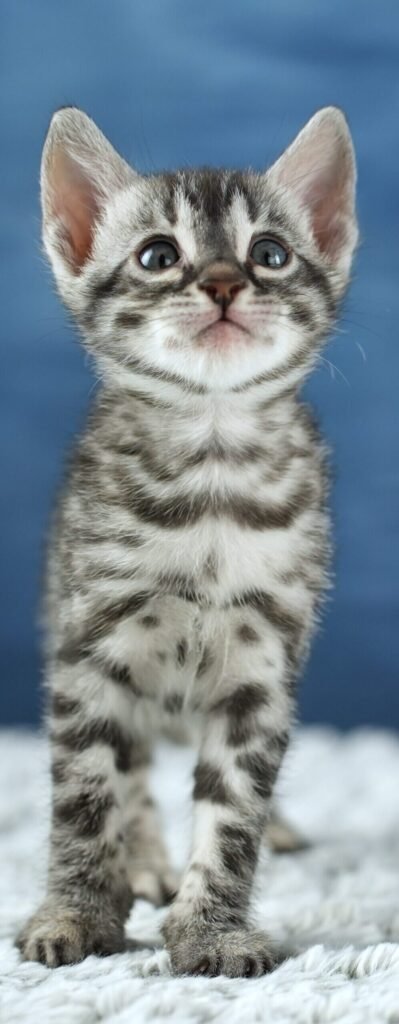
History of the Melanistic Bengal Cats: Panther in a Leopards World
In the Bengal’s early development, breeders primarily sought to create domestic cats with wild-looking spotted patterns. When melanistic individuals occasionally surfaced, they were viewed as an undesirable, solid variation that deviated from the breed’s intended look. Because of this, melanistic Bengals faced many challenges in gaining formal recognition.
As of 2024, The International Cat Association (TICA) does not recognize melanistic Bengals for show purposes, although there is potential for them to gain recognition in the future. The Cat Fanciers Association (CFA) describes melanistic Bengals in the breed’s accepted colors, but their status remains somewhat ambiguous as they have never been awarded any Grand titles.
As appreciation for the melanistic Bengals’ unique panther-like appearance grows, breed standards may evolve to more fully embrace this variation. However, this would require careful consideration to balance the preservation of traditional Bengal characteristics with the acceptance of the melanistic coat.

Charcoal and Melanistic Bengal Genetics
The “A” locus, also known as the Agouti locus, plays a crucial role in developing various coat patterns in Bengal cats, including two distinctive variations: charcoal and melanistic. This locus controls pigment distribution in individual hair shafts, leading to unique coat appearances. The interplay between different alleles at this locus, including those inherited from the Asian Leopard Cat and domestic cats, results in some of the diverse appearances seen in Bengal cats. Understanding the genetics of the “A” locus is key to comprehending how charcoal and melanistic Bengal cats develop their unique characteristics.
Charcoal Bengal cats owe their unique appearance to the Asian Leopard Cat (ALC) agouti allele, “Apb”. This allele can be present in one or two copies, resulting in different shades of charcoal. Two copies of “Apb” (Apb/Apb) typically produce a lighter “Twilight Charcoal,” while one copy of “Apb” combined with one copy of the domestic cat non-agouti allele “a” (Apb/a) usually results in a darker “Midnight Charcoal” variant.
Melanistic Bengal cats inherit two copies of the non-agouti allele “a” (a/a). This double recessive combination results in a solid-colored coat, effectively preventing the normal banding of pigment on individual hairs that creates a tabby pattern. However, the underlying Bengal pattern may still be visible under certain lighting as “ghost markings”.
Both charcoal and melanistic alleles are recessive to the dominant agouti “A” allele found in most Bengal cats. For these traits to appear, a cat must inherit the specific allele combinations from both parents. Understanding these genetic principles allows breeders to predict and produce cats with these special pattern effects.
While our understanding of Bengal cat genetics has grown significantly, it’s important to acknowledge that there may be other modifying genes influencing the exact appearance of charcoal and melanistic Bengals. The complexity of feline genetics means there’s always more to learn about how these alleles interact to create the beautiful and varied appearances we see in Bengal cats.
The study centered on the agouti signaling protein (ASIP) gene, known to be involved in coat color determination. The researchers sequenced the complete coding region of ASIP in Asian leopard cats, domestic cats, and Bengal cats. They identified 27 genetic variants that distinguish leopard cats from domestic cats, including both synonymous and non-synonymous changes in the coding regions, as well as intronic variants.
Specifically, they found four synonymous and four non-synonymous exonic SNPs, along with 19 intronic variants, including a 42-bp deletion in intron 4. These variants formed a distinct leopard cat-specific haplotype.
A key finding was that 56 out of 64 reported charcoal Bengal cats were compound heterozygotes for ASIP, carrying one leopard cat agouti allele (APbe) and one domestic cat non-agouti allele (a). This genetic combination appears to produce the distinctive charcoal phenotype, characterized by darker markings but not complete melanism.
Interestingly, the study also uncovered a previously unknown ASIP haplotype (termed A2) in 24 Bengal cats and a Savannah cat. This haplotype, featuring mutations in exon 2, was not found in the wild felid species examined (leopard cats, servals, or jungle cats), and its origin remains unknown.
The researchers noted that this is the first validation of a leopard cat allele segregating in the Bengal breed and likely affecting their coat appearance. They suggested that the interaction between wild felid and domestic cat alleles can produce unique colorations not seen in other domesticated animals.
The findings have implications for genetic testing in hybrid cat breeds. The presence of wild felid alleles could affect the accuracy of standard tests developed for domestic cats. The researchers recommend caution when performing genetic tests on hybrid cats and suggest that breeders could use this information to more efficiently select for the charcoal coloration.
This peer-reviewed study provides valuable insights into the genetic complexity underlying coat color variations in hybrid cats and highlights the need for further research to fully understand the inheritance patterns and phenotypic effects of these genetic combinations.
Black Bengal Cats for Sale at Pet Perfect Bengals
At Pet Perfect Bengals, we specialize in black Bengal cats, particularly the captivating charcoal Bengals. Our kittens are raised in a nurturing environment, with a focus on their socialization and health from day one. Adopting from us means welcoming a stunning, rare companion and joining a community committed to the highest standards of care. As a TICA and CFA registered cattery, we ensure each kitten undergoes rigorous health and personality screenings, offering you a companion that perfectly matches your family’s needs. Our comprehensive adoption package includes lifetime support and a health guarantee, providing confidence and peace of mind. If you are ready to experience the joy of a Bengal, explore our available kittens or contact Pet Perfect Bengals to begin your journey with these captivating felines.

